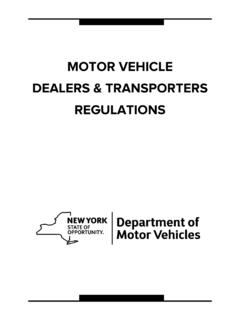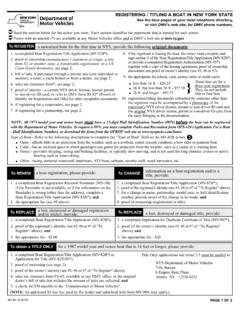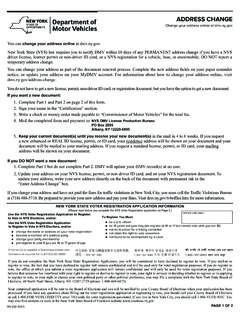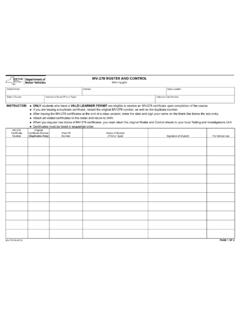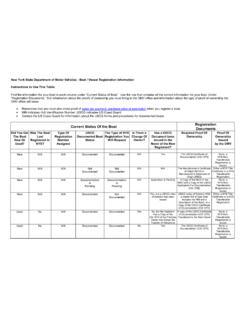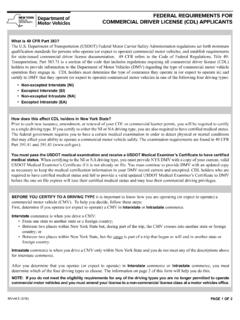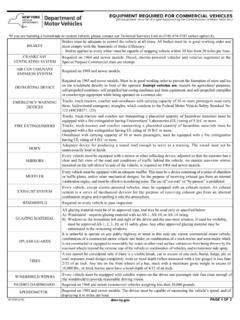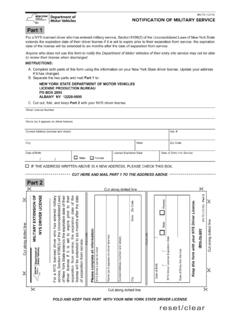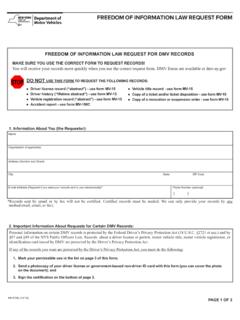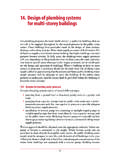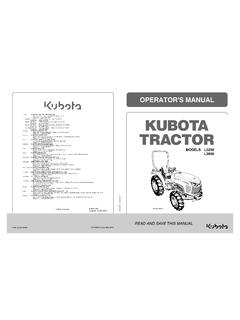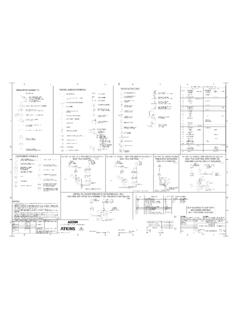Transcription of SECTION 2 DRIVING SAFELY - New York DMV
1 SECTION 2 DRIVING SAFELYThis SECTION CoverslVehicle InspectionlDriving in WinterlBasic Control of Your VehiclelDriving in Very Hot WeatherlShifting GearslRailroad-Highway CrossingslSeeinglMountain DrivinglCommunicatinglDriving EmergencieslControlling SpeedlAntilock Braking Systems (ABS)lManaging SpacelSkid Control and RecoverylSeeing HazardslCrash ProcedureslDistracted DrivinglFireslAggressive Drivers/Road RagelAlcohol, Other Drugs, and DrivinglDriving at NightlStaying Alert and Fit to DrivelDriving in FoglHazardous Materials Rules for AllCommercial Drivers This SECTION contains knowledge and safe DRIVING information that all commercial drivers should know. You must pass a test on this information to get a CDL. This SECTION does not have specific information on air brakes, combination vehicles, doubles, or passenger vehicles.
2 When preparing for the Pre-trip Inspection Test, you must review the material in SECTION 11 in addition to the information in this SECTION . This SECTION does have basic information on hazardous materials (HazMat) that all drivers should know. If you need a HazMat endorsement, you should study SECTION Vehicle Inspection Why InspectSafety is the most important reason you inspect your vehicle, safety for yourself and for other road users. A vehicle defect found during an inspection could save you problems later. You could have a breakdown on the road that will cost time and dollars, or even worse, a crash caused by the defect. Federal and state laws require that drivers inspect their vehicles. Federal and state inspectors also may inspect your vehicles. If they judge the vehicle to be unsafe, they will put it "out of service" until it is fixed.
3 Types of Vehicle InspectionPre-trip pre-trip inspection will help you find problems that could cause a crash or breakdown. During a safety you should:lW atch gauges for signs of your senses to check for problems (look, listen, smell, feel).lCheck critical items when you stop: Tires, wheels and rims. Brakes. Lights and reflectors. Brake and electrical connections to trailer. Trailer coupling devices. Cargo securement 2 DRIVING SAFELY2-1 PageNew york State Commercial Driver s Manual CDL-10 (2/20)TRACTOR JACKNIFELine of TravelDirection Of SlideRear Tractor Wheels Locked-UpOr Spinning After-trip Inspection and should do an after-trip inspection at the end of the trip, day, or tour of duty on each vehicle you operated. It may include filling out a vehicle condition report listing any problems you find.
4 The inspection report helps a motor carrier know when the vehicle needs repairs. What to Look For Tire ProblemslT oo much or too little air wear. You need at least 4/32-inch tread depth in every major groove on front tires. You need2/32 inch on other tires. No fabric should show through the tread or or other tires that come in contact with each other or parts of the and bias-ply tires used or cracked valve , recapped, or retreaded tires on the front wheels of a bus. These are and Rim ProblemslDamaged around wheel nuts may mean the nuts are loose--check tightness. After a tire has beenchanged, stop a short while later and re-check tightness of clamps, spacers, studs, or lugs means , bent, or cracked lock rings are or rims that have had welding repairs are not Brake Drums or ShoeslCracked or pads with oil, grease, or brake fluidon worn dangerously thin, missing,or System DefectslMissing nuts, bolts, cotter keys, or other , loose, or broken parts, such as steeringcolumn, steering gear box, or tie power steering equipped, check hoses,pumps, and fluid level; check for wheel play of more than 10 degrees(approximately 2 inches movement at the rimof a 20-inch steering wheel) can make it hardto steer.
5 Figure illustrates a typical steering 2 DRIVING SAFELY2-2 PageNew york State Commercial Driver s Manual CDL-10 (2/20)Figure SYSTEMS teering WheelTie RodSteering ShaftPowerSteeringCylinderSteering ArmSpindleDrag LinkSteering KnuckiePitman ArmHydraulic Fluid ReservoirGear BoxSuspension System Defects. The suspension system holds up the vehicle and its load. It keeps the axles in place. Therefore, broken suspension parts can be extremely dangerous. Look for:lSpring hangers that allow movement of axlefrom proper position. See Figure or broken spring or broken leaves in any leaf spring(see Figure ). Any defect could be any of the following conditions exist the vehiclewill be placed out of service , and must be repaired:1) One-fourth or more of the leaves in anyspring assembly are broken2) Any leaf or portion of any leaf in anyspring assembly is missing or separated3) Any main leaf in a leaf spring is leaves in a multi-leaf spring or leaves thathave shifted so they might hit a tire or other shock rod or arm, u-bolts, spring hangers, orother axle positioning parts that are cracked,damaged, or suspension systems that are damagedand/or leaking.
6 See Figure loose, cracked, broken, or missingframe System Defects. A broken exhaust system can let poison fumes into the cab or sleeper for:lLoose, broken, or missing exhaust pipes, mufflers, tailpipes, or vertical , broken, or missing mounting brackets, clamps, bolts, or system parts rubbing against fuel system parts, tires, or other moving parts of system parts that are 2 DRIVING SAFELY2-3 PageNew york State Commercial Driver s Manual CDL-10 (2/20)Figure SUSPENSION PARTSH ydraulic Shock AbsorberTorque RodSAFETY DEFECT: BROKEN LEAF IN SPRINGB roken LeafAxleLeal SpringVehicle FrameFront Axle HangerBearing PlatesFrameAxleMain SpringSpring ShackleMain SpringAIR SUSPENSION PARTSF rame ReinforcementHeight Control ValveUpper Bellows SupportShock AbsorberSpacerBracketEye BoltClamp BoltControlAnnAnchorPlateU-BoltsAxleFRON TAxle SeatLower Bellows SupportBellowsEmergency Equipment.
7 Vehicles must be equipped with emergency equipment. Look for:lFire extinguisher(s).lSpare electrical fuses (unless equipped with circuit breakers).lW arning devices for parked vehicles (for example, three reflective warning triangles).Cargo (Trucks).You must make sure the truck is not overloaded and the cargo is balanced and secured before each trip. If the cargo contains hazardous materials, you must inspect for proper papers and placarding. CDL Pre-trip Vehicle Inspection Test In order to obtain a CDL you will be required to pass a skills test that includes a pre-trip vehicle inspection. You will be tested to see if you know whether your vehicle is safe to drive. You will be asked to do a pre-trip inspection of your vehicle and explain to the examiner what you would inspect and why.
8 The following seven-step inspection method should be useful. Seven-step Inspection Method Method of should do a pre-trip inspection the same way each time so you will learn all the steps and be less likely to forget something. Approaching the general condition. Look for damage or vehicle leaning to one side. Look under the vehicle for fresh oil, coolant, grease, or fuel leaks. Check the area around the vehicle for hazards to vehicle movement (people, other vehicles, objects, low-hanging wires, limbs, etc.).Vehicle Inspection GuideStep 1: Vehicle OverviewReview Last Vehicle Inspection may have to make a vehicle inspection report in writing each day. The motor carrier must repair any items in the report that affect safety and certify on the report that repairs were made or were unnecessary.
9 You must sign the report only if defects were noted and certified to be repaired or not needed to be 2: Check Engine Compartment Check That the Parking Brakes Are On and/or Wheels Chocked. You may have to raise the hood, tilt the cab (secure loose things so they don't fall and break something), or open the enginecompartment door. Check the following:lEngine oil level in radiator; condition of steering fluid level; hose condition (if so equipped).lWindshield washer fluid fluid level, connections, and tie downs (battery may be located elsewhere).lAutomatic transmission fluid level (may require engine to be running).lCheck belts for tightness and excessive wear (alternator, water pump, air compressor)--learnhow much "give" the belts should have when adjusted right, and check each in the engine compartment (fuel, coolant, oil, power steering fluid, hydraulic fluid,battery fluid).
10 LCracked, worn electrical wiring and secure hood, cab, or engine compartment 2 DRIVING SAFELY2-4 PageNew york State Commercial Driver s Manual CDL-10 (2/20)Step 3: Start Engine and Inspect Inside the CabGet In and Start EnginelMake sure parking brake is gearshift in neutral (or "park" if automatic).lStart engine; listen for unusual equipped, check the Anti-Lock Braking System (ABS) indicator lights. Light on dash shouldcome on and then go off. If it stays on, the ABS is not working properly. For trailers only, if theyellow light on the left rear of the trailer stays on, the ABS is not working at the GaugeslOil pressure . Should come up to normal within seconds after engine is started. See Figure pressure . pressure should build from 50 to 90 psi within 3 minutes. Build air pressure togovernor cut-out (usually around 120-140 psi; know your vehicle s requirements).
